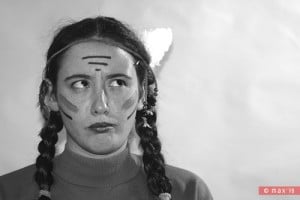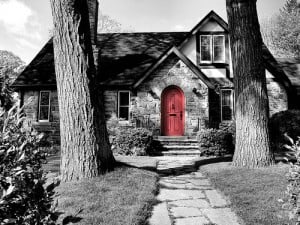I had a dream last night…vivid, involved, realistic. The first thing I remembered from the dream was that I was very self-aware and I was thinking. The time was a few days in the future, the upcoming weekend to be exact, and I was down at the coast for my Masters coursework. I was not at SFU (where I actually do go for my studies), but in a house. I had my binder of articles, my notes, my bag, even my lunch. Everyone in the cohort, including the professor, Dr. Kelly, was there. It was a usual weekend of study…except for the house.
The house that we were in was old and cozy. The rooms were large and opened one onto another. There was a large living room full of seating. I had a spot on one of the couches because, as in real life, I’d been one of the first to arrive for class that day. Even the couch I was sitting on was in the exact same place I usually sit in the room at SFU – I like to situate myself along the back wall facing the prof at the bottom of the ‘U’ shaped table arrangement.
The dream progressed through a normal day of Masters study. I sat on the couch, with my binder in my lap, discussing articles with the group and the people sitting near me. We broke for lunch and I wandered outside with others to sit and eat on the large patio at the rear of the house. The afternoon involved a creative, arts-based activity in the kitchen involving melting wax (haven’t figured that one out yet) and I distinctly recall admiring beautiful owl sculptures that decorated a few of the rooms in the house.
I’ve been peeling away the layers of this dream all day and, as I’m obsessed with it for the day, it’s my musing for the week.
The first layer of interest was that I dreamed about the Masters in the first place. With the life-consuming report card deadline fast approaching, I’ve had little time to devote to MEd studies in the last week. Out of necessity, I’ve had to spend that extra time on assessment and evaluation tasks. I wondered at first if dreaming about the MEd was an indication that my mind needed to spend more time on my studies.
The second layer, too much for my half-awake brain to immediately sort out, was the house. Why the house? Why was it so vivid and so central in my dream? Once I started to wake up, I realized that the house in my dreams was symbolic of Prospect School (now called Prospect Center) from an assigned reading I finished a few days ago.
The reading is from a book entitled “From Another Angle: Children’s Strengths and School Standards: The Prospect Center’s Descriptive Review of the Child” which tells about an amazing school in Bennington, Vermont. The original Prospect School opened in 1965. The teachers at Prospect created their own philosophy of education which included an emphasis on process and inquiry. Also, these educators were, in my mind, dedicated teacher researchers. They designed comprehensive descriptive processes through which to study not only the students and their learning, but also the educational practices taking place within the school.
When I finished the reading I was inspired and impressed by the educational environment that was Prospect School (the school closed in the early 1990s). I hadn’t had a chance to do any writing, or even thinking, on the reading. I think that my mind wasn’t ready to let go of the ideas in the reading, and a detailed, wonderful dream in which I was actually experiencing a meshed SFU/Prospect School was the result.
As I seem to rethink and question everything these days, I started thinking about the dream itself. Why was I even spending the time to make the connections above? It was, after all, only a dream…or was it…
That’s when I came to the last layer. The last layer resonates at a much deeper level and deserves explanation.
In order to better situate myself as a teacher researcher and more fully understand the paradigmatic assumptions through which I view and act within the world, I started to research those who currently influence, and have influenced, my thinking. One of the greatest influences in shaping who I am today was my great-grandmother, or, as we called her, Nanny.
 Nanny’s mother was Metis and her maternal grandmother was Cree. She exemplified the combination of old wives’ tales from her Scottish fur trader father and the common sense based on living in connection with the natural world which, I’m guessing, she received from her Metis and Cree maternal roots. I speculate not only because Nanny passed away peacefully years ago (at the fine age of exactly 99 1/2 years old), but also because my family knows precious little of Nanny’s Metis origins. She was sent away, along with the other three eldest siblings in the family, to ‘boarding school’ (a.k.a. residential school) and never spoke of her aboriginal ties. What we do know about our large Metis family in northern and central Manitoba we have learned since Nanny’s passing. In order to learn more about myself as a teacher researcher, I felt the need to learn about First Nations epistemologies and worldviews, especially those of the Metis and the Cree.
Nanny’s mother was Metis and her maternal grandmother was Cree. She exemplified the combination of old wives’ tales from her Scottish fur trader father and the common sense based on living in connection with the natural world which, I’m guessing, she received from her Metis and Cree maternal roots. I speculate not only because Nanny passed away peacefully years ago (at the fine age of exactly 99 1/2 years old), but also because my family knows precious little of Nanny’s Metis origins. She was sent away, along with the other three eldest siblings in the family, to ‘boarding school’ (a.k.a. residential school) and never spoke of her aboriginal ties. What we do know about our large Metis family in northern and central Manitoba we have learned since Nanny’s passing. In order to learn more about myself as a teacher researcher, I felt the need to learn about First Nations epistemologies and worldviews, especially those of the Metis and the Cree.
One of the more compelling articles I have read so far is a personal narrative by Patricia Steinhauer entitled “Situating myself in research“. The author wrote the article during her Masters coursework and discusses her ‘rubs’ connected to low achievement among students in the reserve system. She returned to graduate coursework with hopes of finding some solutions to these issues and, in particular, mentions a course in Indigenous research methods.
As an aside, I’ve been trying to find the answer to a seemingly simple question – what was ‘research’ called before the birth of the word ‘research’ in the 16th century? – since reading Denzin and Lincoln‘s introduction to The Sage Handbook of Qualitative Research, so the Steinhauer reading definitely caught my interest.
Steinhauer tells about the tasks assigned as part of the Indigenous research methods course:
Here we had several tasks. The first required each of us to select a living object somewhere on campus and to spend an hour with it. The second task was to spend half an hour each evening watching the moon. The final task was to make notes of our dreams.
Herein lies the final layer of my musing. My mother used to, and taught me to as well, record my dreams upon waking. Dreams were important to Nanny, too, and it was commonly believed that she would dream things before they happened. She rarely spoke of such things, but there are enough family stories to make a believer of almost anyone. Although I have no actual evidence, I think that the importance of dreams as a way of making sense of the world was a part of Nanny’s Metis and Cree heritage. ‘Boarding school’ couldn’t erase her worldview, it could only erase her acknowledgment of it.
As a result of my hidden Metis and Cree influences, I believe that dream analysis is a deeply ingrained part of my overall worldview. It’s part of how I make sense of the world, and, in this case, helps me to fully process readings for my Masters degree. I feel comfortable, and somewhat validated, with this new knowledge and thankful that the Masters coursework has helped me to understand this layer hidden for so long inside the core of who I am.


Pingback: Tweets that mention MEd Layers in a Dream | Just a Thought... -- Topsy.com
I’m looking forward to reading the articles. Thanks for sharing!
I used to call my little sister and get her to interpret my dreams. She had a bunch of different dream dictionaries and we’d go through the different possibilities till we found one that suited the situation. Your post reminded me to call her and tell her to unpack her dream books. When she does I’ll get her to interpret your dream!